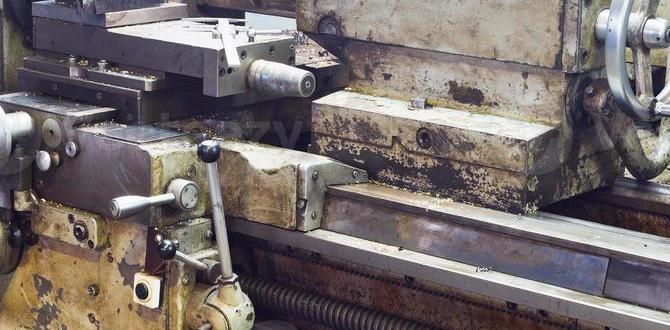Quick Summary: A 3/16 inch carbide end mill is excellent for cutting steel. Its hardness and heat resistance make it a reliable choice for machinists tackling various steel alloys. Learn how to select, use, and care for this versatile tool to achieve precise results in your workshop.
Hey there, fellow makers! Daniel Bates here from Lathe Hub. Are you looking to cut steel with your milling machine but feeling a bit overwhelmed by all the tool options? It’s a common puzzle many beginners face. Choosing the right cutting tool can make the difference between a frustrating struggle and a smooth, successful project. If you’ve ever stared at a pile of steel and wondered which end mill to grab, you’re in the right place. Today, we’re diving deep into the world of the 3/16 inch carbide end mill, especially how it proves its worth when working with steel. We’ll break down exactly why it’s such a fantastic choice and how you can use it confidently. Get ready to feel more in control and equipped for your next steel-cutting adventure!
Why a 3/16 Inch Carbide End Mill is Your Go-To for Steel
When we talk about machining steel, we’re talking about a material that can be tough, abrasive, and prone to generating heat. These qualities demand a cutting tool that’s up to the challenge. This is precisely where the humble 3/16 inch carbide end mill shines.
Carbide, specifically tungsten carbide, is an endgame material for cutting tools. It’s incredibly hard – second only to diamonds in hardness, making it perfect for milling dense materials like steel. But it’s not just about hardness. Carbide also possesses excellent heat resistance. When your end mill bites into steel, friction causes heat. High-speed steel (HSS) tools can soften and lose their edge under these conditions, but carbide holds its ground, allowing for faster cutting speeds and longer tool life.
The 3/16 inch size is particularly versatile for a home workshop or small-scale production. It’s small enough for intricate detail work and light enough to be managed by most common milling machines. It’s the sweet spot for many tasks, from engraving to slotting and creating pockets in steel parts. Whether you’re working with mild steel, tool steel, or even some of the tougher, heat-resistant alloys, a 3/16 inch carbide end mill, especially those with an 8mm shank for added rigidity or a long reach for deeper cuts, often becomes an indispensable part of the machinist’s toolkit.
Understanding Carbide End Mill Specifications
Before you grab the first 3/16 inch carbide end mill you see, let’s talk about what makes them different and how to choose the right one for your steel-cutting needs. It’s not just about the size; there are nuances that greatly impact performance and longevity.
Material and Coatings
Most 3/16 inch end mills designed for steel are made from solid tungsten carbide. However, the quality of the carbide can vary. Look for reputable brands that specify the grade of carbide or mention things like “sub-micron grain carbide,” which generally indicates superior toughness and wear resistance.
Coatings play a crucial role in enhancing performance, especially when cutting hard materials like steel. Common coatings include:
- TiN (Titanium Nitride): A general-purpose coating that offers improved hardness and lubricity, reducing friction and heat. It provides a gold appearance.
- TiCN (Titanium Carbonitride): Harder and more abrasion-resistant than TiN, making it excellent for cutting steels and cast iron. It has a greyish-purple hue.
- TiAlN (Titanium Aluminum Nitride): This is a top performer for high-temperature applications and cutting stainless steels and superalloys. It forms a protective oxide layer at high temperatures. It typically appears dark grey or black.
- AlTiN (Aluminum Titanium Nitride): Similar to TiAlN but often offers even better thermal stability and wear resistance, ideal for demanding steel machining.
- Uncoated: While less common for high-performance steel cutting, some uncoated carbide end mills are available. They rely purely on the carbide’s inherent properties and often require more diligent coolant application.
For steel, especially harder steels or when you want maximum tool life and speed, a TiAlN or AlTiN coated end mill is often the best bet. A good coolant strategy is also essential, and you can learn more about metal cutting coolants from resources like Machinery Lubricants.
Flute Count
The number of flutes (the helical cutting edges) on an end mill affects its performance:
- 2-Flute: Excellent for slotting, plunging, and chip evacuation in softer materials. For steel, they can work but may require slower feed rates to avoid chip packing.
- 3-Flute: A good compromise. Offers better rigidity and chip load capacity than 2-flutes, making them suitable for general-purpose milling in steel.
- 4-Flute: Typically provides the best rigidity and chip load capacity, making them ideal for heavy milling operations in steel. They are excellent for side milling and general roughing.
For general-purpose 3/16 inch carbide end mill work in steel, a 3-flute or 4-flute end mill is usually recommended. The 4-flute offers more chip space and better heat dissipation, which is critical when milling steels.
Shank Diameter and Length (Reach)
While we’re focusing on a 3/16 inch cutting diameter, the shank, the part that goes into your machine’s collet or tool holder, is also important. Common shank sizes are 1/4 inch, 3/8 inch, 1/2 inch, and metric sizes like 6mm or 8mm. A 3/16 inch end mill might have a corresponding smaller shank, but it’s also common to find them with larger shanks (e.g., a 3/16″ cutter with an 8mm shank). A larger shank provides greater rigidity, helping to prevent chatter and deflection, which is very beneficial when cutting harder materials like steel.
Reach refers to the length of the flutes. A standard length is good for most operations. A “long reach” or “extended reach” end mill has a significantly longer distance from the shank to the tip of the flutes. This allows you to machine deeper pockets or features. However, longer reach end mills are less rigid and more prone to vibration, so you’ll need to reduce cutting speeds and feed rates accordingly when using them in steel.
Corner Radius (Square End vs. Corner Radius)
Most 3/16 inch end mills are “square end,” meaning they have sharp 90-degree corners. These are great for creating square shoulders and sharp internal corners. However, sharp corners are also weak points and can chip easily, especially in hard materials. For tougher steel applications, you might consider an end mill with a small corner radius (e.g., 0.010″ or 0.020″). A radiused corner adds strength to the cutting edge, making it more resistant to chipping and extending tool life.
Choosing the Right 3/16 Inch Carbide End Mill for Your Steel Project
So, how do you translate this knowledge into a practical choice for your specific steel project? Here’s a decision-making guide:
| Project Type | Recommended 3/16″ Carbide End Mill Specs | Reasoning |
|---|---|---|
| General Slotting/Pockets (Mild Steel) | 3 or 4 flutes, TiN or TiCN coating, standard length, square end | Good balance of chip evacuation and rigidity for common steel. TiN/TiCN offers basic protection. |
| Roughing/Material Removal (Harder Steels) | 4 flutes, TiAlN or AlTiN coating, standard length, square end or small corner radius | 4 flutes for high chip load and rigidity. TiAlN/AlTiN for heat resistance. Corner radius for edge strength. |
| Detailed Engraving/Marking (Any Steel) | 2 or 4 flutes (depending on rigidity needed), high polish or special coating, standard length | Precision is key. High polish helps with chip flow for fine details. 4-flute can offer more stability if the machine allows. |
| Deep Pocket Machining (Any Steel) | 3 or 4 flutes, TiAlN or AlTiN coating, LONG REACH, small corner radius | Long reach is essential. TiAlN/AlTiN handles heat. Corner radius prevents chatter in the deeper sections. Reduced speeds/feeds will be necessary. |
| Heat-Resistant Alloys (e.g., Stainless Steel) | 4 flutes, TiAlN or AlTiN coating, standard or extended reach, small corner radius | These materials require excellent heat management and edge strength. TiAlN/AlTiN is crucial. |
Always remember that for the toughest steels, such as certain stainless steels or tool steels, you’ll need to slow down your cutting speeds and feed rates and ensure adequate coolant is used. For more on cutting speeds and feeds, the Sandvik Coromant website offers valuable resources for understanding these fundamental machining parameters.
Essential Machining Practices for Steel with a Carbide End Mill
Having the right tool is only half the battle. Using it correctly is critical for safety, tool life, and achieving good results when machining steel.
Setting Up Your Machine
1. Secure Workholding: This is paramount. Steel is tough, and the forces generated during milling can be significant. Ensure your workpiece is rigidly held in a vise, clamped securely, or fixtured properly. Any movement can lead to tool breakage, poor surface finish, or severe injury. For small parts, a good quality milling vise is often sufficient. For larger or irregularly shaped parts, specialized clamps or a custom fixture might be necessary.
2. Collet Selection: Use a high-quality collet system to hold your end mill. ER collets are very popular and offer good runout accuracy. Ensure the collet is the correct size for your 8mm shank (or whatever shank size you have) and that it’s clean. A clean collet allows for maximum grip pressure.
3. Runout: Minimize runout (wobble) of the end mill. Excessive runout puts uneven stress on the cutting edges, leading to chatter, poor surface finish, and premature tool failure. A good collet and a clean spindle can help achieve minimal runout. If you suspect high runout, you can use an indicator to check once the tool is in the spindle.
Coolant and Lubrication
Steel generates a lot of heat when machined. While carbide is heat-resistant, excessive heat will still degrade its performance and shorten its life. Coolant serves several purposes:
- Cooling: It dissipates heat away from the cutting zone, preventing the tool and workpiece from overheating.
- Lubrication: It reduces friction between the cutting edge and the workpiece, allowing for smoother cutting and a better surface finish.
- Chip Evacuation: It helps wash chips away from the cutting area, preventing them from re-cutting and damaging the tool or workpiece. For shallow cuts, a good blast of air can also help, but for deeper cuts or tougher steels, a liquid coolant is highly recommended.
You can use compressed air, a mist coolant system, or a flood coolant system. For steel, a flood coolant or a good quality mist system is often the most effective. Ensure your coolant is properly mixed and maintained.
Speeds and Feeds: The Delicate Balance
This is often the most intimidating part for beginners, but it’s crucial for success. For a 3/16 inch carbide end mill in steel:
Surface Speed (SFM): For carbide in steel, this can range from about 150 SFM to over 500 SFM, depending on the steel type, coating, coolant, and machine rigidity. A good starting point for mild steel with a TiAlN coated end mill might be around 250-350 SFM. Always start conservatively.
Spindle Speed (RPM): This is calculated from your desired Surface Speed (SFM) and the diameter of your end mill (D). The formula is: RPM = (SFM x 3.82) / D (where D is in inches).
For a 3/16″ (0.1875″) end mill at 250 SFM:
RPM = (250 x 3.82) / 0.1875 = 5100 RPM (approximately)
Feed Per Tooth (IPT): This is how much the tool advances with each cutting edge. For a 3/16″ carbide end mill in steel, IPT can range from 0.001″ to 0.005″ or more, depending on the number of flutes, machine rigidity, and depth of cut. A good starting point for a 4-flute end mill might be 0.002″ per tooth.
Feed Rate (IPM): This is the actual speed your machine’s table moves. It’s calculated as: IPM = RPM x IPT x Number of Flutes.
At 5100 RPM, with a 4-flute end mill and 0.002″ IPT:
IPM = 5100 x 0.002 x 4 = 40.8 IPM (approximately)
These are just starting points! Always consult manufacturer recommendations if available. If you hear excessive chatter, see poor surface finish, or notice chips welding to the tool, you’ll need to adjust. Often, a slight reduction in feed rate or an increase in spindle speed (if the machine can handle it without deflection) is beneficial.
Depth of Cut (DOC) and Width of Cut (WOC)
Depth of Cut (DOC): How deep the end mill cuts into the material in one pass. For roughing operations in steel, you can often take a relatively deep DOC, but this depends heavily on your machine’s rigidity and the end mill’s length. A common rule of thumb for rigid setups is to take a DOC that is around 0.5x to 1x the end mill’s diameter. For a 3/16″ end mill, this would be roughly 0.09″ to 0.18″. For finishing, you’ll want a much shallower DOC, perhaps 0.005″ to 0.010″.
Width of Cut (WOC): How wide the end mill cuts across the material. For slotting, you’ll typically use the full diameter (100% WOC). For side milling or profiling, you often take a partial width of cut. Taking too wide a cut can overload the end mill, so it’s often better to make multiple passes with a narrower WOC.
For steel, it’s generally better to take a deeper DOC and a narrower WOC, or multiple passes with reasonable DOC and WOC, especially if you are not using a high-performance machine. The Carbide Processors website has a handy calculator that can help you find starting points for feeds and speeds.
Toolpath Strategies
For roughing operations, especially in harder steels, “climb milling” (also known as conventional milling) is often preferred. In climb milling, the cutter rotates in the same direction as the feed motion. This tends to produce a better surface finish and prolongs tool life because the chip is thinned as it’s cut. In traditional milling (where the cutter rotation is against the feed direction), the tool “climbs” over the material, which can cause chatter and lead to edge chipping.
For finishing passes, a more precise toolpath is required to achieve the desired surface finish and dimensional accuracy. You might use a step-over that is a percentage of the end mill’s diameter. For a 3/16″ end mill, a step-over of 20-40% of the diameter is common for finishing.
Caring for Your 3/16 Inch Carbide End Mill
Like any precision tool, your carbide end mill will perform best and last longest if you take care of it. Here’s how:
- Clean Thoroughly: After each use, clean your end mill. Remove any residual chips, coolant, or cutting fluid. A stiff brush and some solvent (like denatured alcohol) are usually sufficient.







